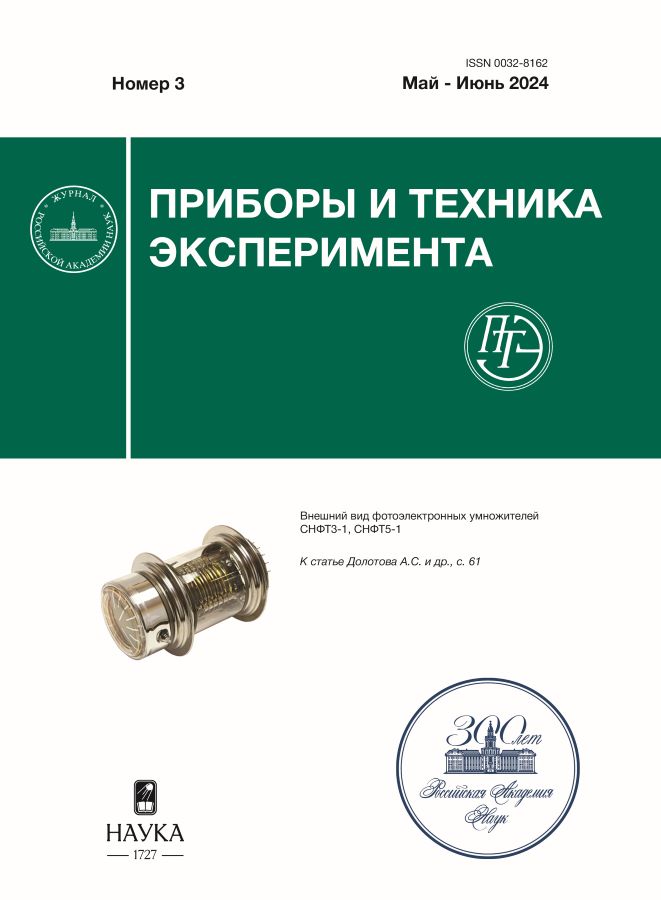Разработка высокогранулярного времяпролетного детектора нейтронов для эксперимента BM@N
- Authors: Губер Ф.Ф.1, Голубева М.Б.1, Зубанков А.А.1,2, Ивашкин А.П.1, Известный А.В.1, Карпушкин Н.М.1, Ляпин Д.Д.1,2, Мамаев М.В.1,2, Махнёв А.И.1,3, Морозов С.В.1, Парфенов П.Е.1,2, Серебряков Д.В.1, Финогеев Д.А.1, Шабанов А.И.1
-
Affiliations:
- Институт ядерных исследований Российской академии наук
- Национальный исследовательский ядерный университет “МИФИ”
- Московский физико-технический институт
- Issue: No 3 (2024)
- Pages: 14-24
- Section: ТЕХНИКА ЯДЕРНОГО ЭКСПЕРИМЕНТА
- URL: https://freezetech.ru/0032-8162/article/view/682607
- DOI: https://doi.org/10.31857/S0032816224030039
- EDN: https://elibrary.ru/OVZKEE
- ID: 682607
Cite item
Abstract
Приводится описание конструкции детектора HGND (Highly Granular Neutron Detector) для измерения азимутальных потоков нейтронов с энергиями от 300 до 4000 МэВ, образующихся в столкновениях тяжелых ионов в эксперименте BM@N (Barionic Matter at Nuclotron) на выведенном пучке ускорителя “Нуклотрон” ОИЯИ (Дубна) при энергиях пучков 2–4 АГэВ. Детектор состоит из 16 слоев пластиковых сцинтилляционных детекторов, имеющих ячеистую структуру, с медными поглотительными пластинами между слоями. Представлены результаты измерения временного разрешения сцинтилляционных ячеек с использованием кремниевых фотодетекторов. Описана предлагаемая схема электроники считывания сигналов со сцинтилляционных ячеек. Приведены результаты моделирования аксептанса нейтронного детектора, эффективности регистрации нейтронов, разрешения по энергии нейтронов и оценка скоростей счета нейтронов для реакции Bi+Bi при энергии 3 АГэВ.
Full Text
About the authors
Ф. Ф. Губер
Институт ядерных исследований Российской академии наук
Email: karpushkin@inr.ru
Russian Federation, 117312, Москва, просп. 60-летия Октября, 7а
М. Б. Голубева
Институт ядерных исследований Российской академии наук
Email: karpushkin@inr.ru
Russian Federation, 117312, Москва, просп. 60-летия Октября, 7а
А. А. Зубанков
Институт ядерных исследований Российской академии наук; Национальный исследовательский ядерный университет “МИФИ”
Email: karpushkin@inr.ru
Russian Federation, 117312, Москва, просп. 60-летия Октября, 7а; 115409, Москва, Каширское шоссе, 31
А. П. Ивашкин
Институт ядерных исследований Российской академии наук
Email: karpushkin@inr.ru
Russian Federation, 117312, Москва, просп. 60-летия Октября, 7а
А. В. Известный
Институт ядерных исследований Российской академии наук
Email: karpushkin@inr.ru
Russian Federation, 117312, Москва, просп. 60-летия Октября, 7а
Н. М. Карпушкин
Институт ядерных исследований Российской академии наук
Author for correspondence.
Email: karpushkin@inr.ru
Russian Federation, 117312, Москва, просп. 60-летия Октября, 7а
Д. Д. Ляпин
Институт ядерных исследований Российской академии наук; Национальный исследовательский ядерный университет “МИФИ”
Email: karpushkin@inr.ru
Russian Federation, 117312, Москва, просп. 60-летия Октября, 7а; 115409, Москва, Каширское шоссе, 31
М. В. Мамаев
Институт ядерных исследований Российской академии наук; Национальный исследовательский ядерный университет “МИФИ”
Email: karpushkin@inr.ru
Russian Federation, 117312, Москва, просп. 60-летия Октября, 7а; 115409, Москва, Каширское шоссе, 31
А. И. Махнёв
Институт ядерных исследований Российской академии наук; Московский физико-технический институт
Email: karpushkin@inr.ru
Russian Federation, 117312, Москва, просп. 60-летия Октября, 7а; 141701, Долгопрудный, Московская обл., Институтский пер., 9
С. В. Морозов
Институт ядерных исследований Российской академии наук
Email: karpushkin@inr.ru
Russian Federation, 117312, Москва, просп. 60-летия Октября, 7а
П. Е. Парфенов
Институт ядерных исследований Российской академии наук; Национальный исследовательский ядерный университет “МИФИ”
Email: karpushkin@inr.ru
Russian Federation, 117312, Москва, просп. 60-летия Октября, 7а; 115409, Москва, Каширское шоссе, 31
Д. В. Серебряков
Институт ядерных исследований Российской академии наук
Email: karpushkin@inr.ru
Russian Federation, 117312, Москва, просп. 60-летия Октября, 7а
Д. А. Финогеев
Институт ядерных исследований Российской академии наук
Email: karpushkin@inr.ru
Russian Federation, 117312, Москва, просп. 60-летия Октября, 7а
А. И. Шабанов
Институт ядерных исследований Российской академии наук
Email: karpushkin@inr.ru
Russian Federation, 117312, Москва, просп. 60-летия Октября, 7а
References
- Sorensen A., Agarwal K., Brown K. et al. // e-Print: 2301.13253. Available online 20 December 2023. https://arxiv.org/abs/2301.13253
- Senger P. // Phys. Scripta 2021. V. 96. P. 054002. https://doi.org/10.1088/1402-4896/abebfe
- Le Fèvre A., Leifels Y., Reisdorf W., Aichelin J., Hartnack Ch. // Nucl. Phys. A. 2016. V. 945. P. 112. https://doi.org/10.1016/j.nuclphysa.2015.09.015
- Leifels Y., Blaich T., Elze T. et al. // Phys. Rev. Lett. 1993. V 71. P. 963. https://doi.org/10.1103/PhysRevLett.71.963
- Lambrecht D., Blaich T., Elze T. et al. // Z. Phys. A. 1994. V. 350. P. 115. https://doi.org/10.1007/BF01290679
- Russotto P., Wu P.Z., Zoric M. et al. // Phys. Lett. B. 2011. V. 697. P. 471. https://doi.org/10.1016/j.physletb.2011.02.033
- LAND Collab., Blaich T., Elze T., Emling H. et al. // Nucl. Instrum. Methods Phys. Res. Sect. A. 1992. V. 314. P. 136. https://doi.org/10.1016/0168-9002(92)90507-Z
- Russotto P., Le Fèvre A., Łukasik J. et al. // arXiv: 2105.09233v1 May 2021. https://arxiv.org/abs/2105.09233
- Boretzky K., Gašparić I., Heil M. et al. // Nucl. Instrum. Methods Phys. Res. Sect. A. 2021. V. 1014. P. 165701. https://doi.org/10.1016/j.nima.2021.165701
- Senger P. // Particles. 2022. V. 5(1). P. 21. http://dx.doi.org/10.3390/particles5010003
- E895 Collab., Pinkenburg C., Ajitanand N., Alexander J. et al. // Phys. Rev. Lett. 1999. V. 83. P. 1295. https://doi.org/10.1103/PhysRevLett.83.1295
- E895 Collab., Liu H., Ajitanand N., Alexander J. et al. // Phys. Rev. Lett. 2000. V. 84. P. 5488. https://doi.org/10.1103/PhysRevLett.84.5488
- E895 Collab., Chung P., Ajitanand N., Alexander J. et al. // Phys. Rev. C. 2002. V. 66. P. 021901. https://doi.org/10.1103/PhysRev C.66.021901
- Senger P. // Universe. 2021. V. 7(6). P. 171. https://doi.org/10.3390/universe7060171
- Senger P. // PoS CPOD2021. 2022. V. 400. P. 033. https://doi.org/10.22323/1.400.0033
- Kapishin M. // JPS Conf. Proc. 2020. V. 32. P. 010093. http://doi.org/10.7566/JPSCP.32.010093
- EQR15 Series SiPMs. http://www.ndl-sipm.net/PDF/Datasheet-EQR15.pdf
- Eljen Technology. https://eljentechnology.com/products/plastic-scintillators/ej-228-ej-230
- Guber F., Ivashkin A., Karpushkin N. et al. // e-Print: 2309.03614. Available online 20 December 2023. https://arxiv.org/abs/2309.03614
- Karpushkin N., Guber F., Finogeev D. et al. // e-Print: 2308.08341. Available online 20 December 2023. https://arxiv.org/abs/2308.08341
- Finogeev D., Guber F., Izvestnyy A. et al. // Nucl. Instrum. Methods Phys. Res. Sect. A. 2024. V. 1059. P. 168952. ISSN 0168-9002. https://doi.org/10.1016/j.nima.2023.168952
- Amelin N., Gudima K., Toneev V. // Sov. J. Nucl. Phys. 1990. V. 51(2). P. 327.
- Baznat M., Botvina A., Musulmanbekov G., Toneev V., Zhezher V. // Phys. Part. Nucl. Lett. 2020. V. 17. P. 303. https://doi.org/10.1134/S1547477120030024
- Brun R., Bruyant F., Carminati F., et al. // CERN Program Library, CERN, Geneva, Switzerland, 1993 Report number: CERN-W5013. https://doi.org/ 10.17181/CERN.MUHF.DMJ1.
- BMNROOT. https://git.jinr.ru/nica/bmnroot
Supplementary files






















